Ijraset Journal For Research in Applied Science and Engineering Technology
- Home / Ijraset
- On This Page
- Abstract
- Introduction
- Conclusion
- References
- Copyright
Correlation Between Urban Literacy Rate and Urban Sex Ratio in Parbhani District Maharashtra: A Geographical Analysis
Authors: Ajitsing S. Solanke , Khadke P. A.
DOI Link: https://doi.org/10.22214/ijraset.2022.48161
Certificate: View Certificate
Abstract
This article investigates the correlation between urban literacy and the urban sex ratio in the Parbhani district. Education forms an important component in the overall development of individuals, enabling them to have greater awareness, and better comprehension of their social, political, and cultural environment and also facilitating the importance of their socio-economic conditions. Literacy rate (LR) is defined as the percentage of literates among the population aged seven years and above. Literacy is one of the significant indicators for the overall development of the human being. The sex ratio is used to determine gender equality in the population. In India, the number of females per 1000 males determines the sex ratio of the people. The literacy rate of the total population of the urban Parbhani district has increased from 52.58 percent to 69.21 percent in 1991 and in 2011 respectively. The increasing percentage is 16.63 during the two-decade period in the district. There is an overall development in the literacy rate of the district.in 1991 the urban sex ratio of the district was 924 and according to the census of 2011, the sex ratio is 958 respectively.
Introduction
I. INTRODUCTION
The human development is mainly indexed by the literacy rate of the area and it indicates the status of human life in the area. It indicates levels of economic development and mainly the birth rate of the area gets affected. Living standards of area, status of women in the area and development of the technology in the area gets developed by the increasing literacy rate of the area. Human development is mainly caused by the education and it is accepted as the main component for it. It makes the society of the area accountable and comprehensible. Sex ratio is one of the basic demographic characteristics of population, which is directly depends on birth death and marriage. It is expressed in terms of numbers of female with respect to per thousand males. The imbalances between two sexes create serious problem in community. Yannawar V.B. (2015) It is one of the important factors in the development of country and has social as well as demographic implications. It also helps in analysis and planning of other demographic characters like migration, fertility, morality and economic structure. The slower growth and lower fertility are consequences of the major imbalances in sex ratio. For a proper understanding of demographic attributes in any region sex ratio analysis is crucial element. The sex ratio also influences marriage and growth rate of the population.
The selected Parbhani district as study area of sex ratio during research, we found that there was decrease in sex ratio, sex ratio for Parbhani district was always the highest whereas Maharashtra state recorded the lowest sex ratio throughout the investigated period. The highest decline trend since 1981 was observed in Parbhani district, while in the 2011, entire study area recorded lowest number of females per thousand males. Hence, for the detail and micro level analysis tehsil-wise, spatio temporal analysis has been made in the research, it also helped to examine the geographical and other factors affecting the sex ratio of the study region Yannawar et al., (2013). There are many tools of statistical analysis and one of them is the correlation. it is used to determine the relationship between the two variables. Various methods are used in correlation analysis and different techniques are used for studying and measuring the scope of variables of the correlation and its relationship between them, by the simple definition correlation means relation between two variables that is, these variables are dependent and independent in nature Waghmare et al., (2013).
A. Study Area
The Parbhani district part of Marathwada region of Maharashtra and present between 18? 45' North to 20? 01' latitudes and 76? 13'East to 77? 26' East longitude.
The total population of Parbhani districts was 1836086 persons according to (2011 census) which is 1.63 percent of total population in Maharashtra and male 942870 and female are 893216. The Parbhani district covers an area of 6214 sq. km which forms 2.11% of the total geographical area of Maharashtra state. with average height 357.50 meters from mean sea level. In the northern side Buldhana, western side Jalana, southern side Beed and Latur and in the eastern side Nanded district are present. Parbhani district includes 9 tehsil Parbhani, Jintur, Gangakhed, Pathri, Purna, Palam, Selu, Sonpeth and Manwath Khadke and Waghmare (2017).
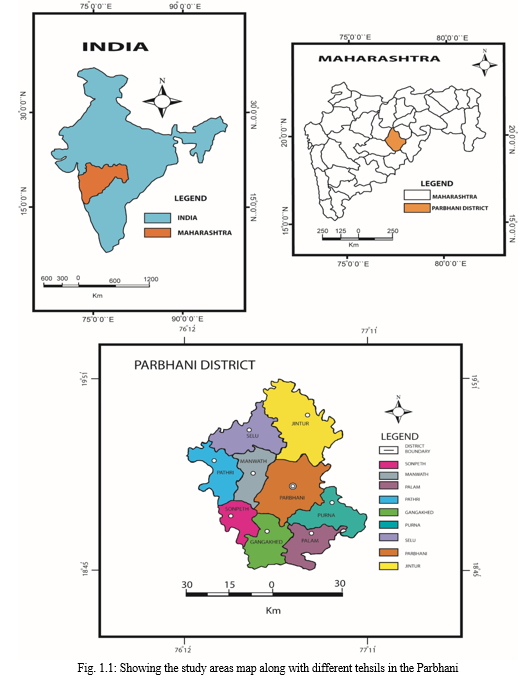
II. MATERIAL AND METHODOLOGY
The study based on secondary data which is obtained from the census of India 1991, 2001, 2011 respectively. In the present study two variables are used the variables are literacy and sex ratio of urban Parbhani. The spearman`s correlation statistical method is used for analysis of secondary data to achieve the main aim. The achieved data has been tabulated by graphs and maps Shinde (2016). The formula used for the analysis of variables are spearman`s rank correlation Sopher (1974) and Sopher (1980).

III. RESULTS
A. Comparison of Literacy in Parbhani Maharashtra
The literacy rate of the country is increasing day by day and also the literacy rate of Maharashtra and urban Parbhani is also increasing. In 1991 the literates of the Maharashtra were 67.07 percent and according to the census of India 2011 the literate rate of Maharashtra is 78.85 percent. There is 11.78 percent increase in the literacy rate during the two decades.
In 1991 the literate rate of the Parbhani was 52.58 percent and in 2011it is 69.21 percent has been recorded. There is 16.63 percent increase in the literacy rate of the urban Parbhani during two decades. The overall literate rate of India is 52.2 in 1991 and 74.00 percent in 2011 respectively. However, literacy of Parbhani is in 1991 and it is low in 2011 as compare to India, Suvasree (2013) and Suman and Seema (2014).
B. Town & City Wise Comparison of Urban Literacy
The literacy rate of male and female of town and city were calculated with the help of census year 1991, 2001 and 2011 distinctly.
C. Persons Literacy Percentage (%)
|
Level of Literacy % |
1991 |
2001 |
2011 |
|
Low (Below 60) |
Sailu, Jintur, Manwath, Pathri, Gangakhed, Parbhani, Purna, Sonpeth (8) |
Pathri, Sonpeth, Gangakhed (3) |
- |
|
Medium (60 to 65) |
- |
Sailu, Jintur, Manwath (3) |
Sonpeth (1) |
|
High (65 to 70) |
- |
Parbhani, Purna (2) |
Sailu, Jintur, Manwath, Pathri, Gangakhed (5) |
|
Very High (Above 70) |
- |
- |
Parbhani, Purna (2) |
Table 3.1: Urban Person Literacy
Source - Compiled by researcher based on census 1991, 2001 and 2011
In 1991 all above mentioned towns (Sailu, Jintur, Manwath, Pathri, Gangakhed, Purna, Sonpeth) and Parbhani city shows Literacy rate below 60 percent. In 2001 below 60 percent literacy rate was found in Pathri, Sonpeth and Gangakhed towns. The 60 to 65 percent literacy was found in Sailu, Jintur and Manwath. Purna town and Parbhani city shows the 65 to 70 percent literacy rate. 2001, there is no any town and city above 70 percent literacy. In 2011, there is no any towns and city below 60 percent literacy rate category. Sonpeth town have 60 to 65 percent literacy. Percentage with 65 to 70 percent literacy is found in Sailu, Jintur, Manwath, Pathri, and Gangakhed town. Parbhani city and Purna town shows above 70 percent very high literacy rate.
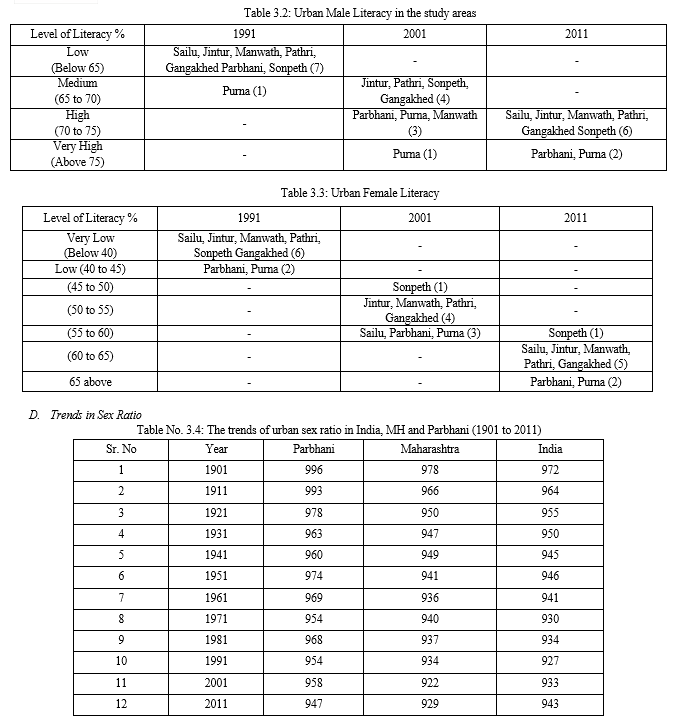
Table No. 3.4 displays changing pattern of the sex ratio of Parbhani district from 1901 to 2011. The sex ratio of Parbhani always remained below 1000. The Parbhani district always has higher sex ratio than the Maharashtra and India. Within India sex ratio decreases from 910 to 941 females within 1901 to 1961 after that continuous increasing trend is observed.
The sex ratio of Maharashtra state 978 in 1901 which has reached 929 females per 1000 males in the 2011 with increasing and decreasing trends in between years. From 1901 to 1941 sex ratio of Parbhani district shows decreasing trend from 978 to 949 after that trend is not constant some years show increase where as some years show decrease in the sex ratio. The recent sex ratio of Parbhani district is 947 according to 2011 census. Which is lowest of all the decades in 2011 census India and Maharashtra having sex ratio 943 and 929 respectively.
Table No. 3.5: Parbhani District urban sex ratio (1901 to 2011)
|
Sr. No. |
Year |
Males |
Females |
Total |
Sex Ratio |
Decadal change |
Females % of Population |
|
1 |
1901 |
17029 |
16918 |
33947 |
993 |
-- |
48.84 |
|
2 |
1911 |
19625 |
19101 |
38726 |
973 |
-20 |
49.32 |
|
3 |
1921 |
23518 |
22244 |
45762 |
946 |
-27 |
48.61 |
|
4 |
1931 |
32906 |
30172 |
63078 |
917 |
-29 |
47.83 |
|
5 |
1941 |
37542 |
34920 |
72462 |
930 |
13 |
48.19 |
|
6 |
1951 |
51714 |
49413 |
101127 |
956 |
25 |
48.86 |
|
7 |
1961 |
56846 |
52706 |
109552 |
927 |
-28 |
48.11 |
|
8 |
1971 |
86736 |
78879 |
165615 |
909 |
-18 |
47.63 |
|
9 |
1981 |
125834 |
117223 |
243057 |
932 |
22 |
47.83 |
|
10 |
1991 |
189179 |
174861 |
364040 |
924 |
-7 |
48.03 |
|
11 |
2001 |
250462 |
234724 |
485186 |
937 |
13 |
48.38 |
|
12 |
2011 |
290984 |
278822 |
569806 |
958 |
21 |
48.93 |
The observed urban sex ratio of the Parbhani district during the decade of 1901 to 2011 is given in the table No. 3.5. The highest sex ratio though out the decades was shown by the 1901 census data and the exact proportion was observed i.e., 16918 females against 17029 males in this way it talks about the ratio of 993 females every 1000 males. The census data of 1971 observed the lowest sex ratio throughout the decade and it was clearly mentioned that 78879 females against 86736 males which produced a sex ratio of 909 females every 1000 males. The decreasing trend observed during the census data of 1911 to 1931. Such as 973 females and 917 females per 1000 males in 1911 and 1931 census respectively. The increased sex ratio i.e., 49413 females against 51714 males observed in 1951 census data and produced a ratio of 956 females behind the 1000 males. The urban sex ratio data was slightly increased during the 1981 to 2011 census data. The observed data shows 909 females behind the 1000 males in 1971 census while 958 females every 1000 males observed in 2011 which shows gradual increase in sex ratio.
Table No. 3.6: Parbhani District town and city wise sex ratio
|
Sr. No |
Town |
Sex Ratio |
Changes of Sex Ratio |
|||||
|
1981 |
1991 |
2001 |
2011 |
1981 to 1991 |
1991 to 2001 |
2001 to 2011 |
||
|
1 |
Selu |
948 |
940 |
923 |
944 |
-8 |
-17 |
21 |
|
2 |
Jintur |
951 |
925 |
912 |
958 |
-26 |
-13 |
46 |
|
3 |
Parbhani |
908 |
915 |
936 |
962 |
7 |
21 |
26 |
|
4 |
Manwath |
966 |
955 |
964 |
966 |
-11 |
9 |
2 |
|
5 |
Pathri |
953 |
941 |
944 |
937 |
-12 |
3 |
-7 |
|
6 |
Sonpeth |
977 |
941 |
936 |
942 |
-36 |
-5 |
6 |
|
7 |
Gangakhed |
954 |
928 |
950 |
952 |
-26 |
22 |
2 |
|
8 |
Purna |
930 |
918 |
947 |
970 |
-12 |
29 |
23 |
|
District Average |
932 |
924 |
937 |
958 |
-8 |
13 |
21 |
|
The town wise sex ratio of Parbhani district illustrated below. The Parbhani city is showing constant increase in sex ratio from 1981 to 2011in contrast with other town and cities which are shows initial decreased and after that increasing trend is observed. According to 1981 census Sonpeth town is having highest (977) sex ratio whereas Parbhani city shows lowest value 908. Sex ratio in Selu, Jintur and Sonpeth towns shows decreasing trend from 1981 up to 2011 and after that increasing trend recorded in the 2011 census.
A simple 4 different types of trends are observed in sex ratio during the period1981 to 2011 viz. (1) In three town namely Selu (-8, -17), Jintur (-26, -13) and Sonpeth (-36, -5) sex ratio decreased in 1981 to 2001 and in 2011 it increases 21, 46 and 6 for the town Selu, Jintur and Sonpeth respectively. (2) In Parbhani city, positive trend is observed in sex ratio from 1981 to 2011 (7, 21 and 26). (3) Towns like Gangakhed (-26, 22 and 2), Manwath (-11,9 and 2) and Purna (-12,29 and 23) shows negative sex ratio for the year 1981 to 1991, but from 2001 to 2011it shows slightly positive value. (4) Pathri is the only town where sex ratio (-13) for the period 1981 to 1991; increases in 2001 (from -13 to 3), but again in 2011 it decreases (from 3 to -7).
E. Urban Sex Ratio
|
Sex ratio |
1981 |
1991 |
2001 |
2011 |
|
Below 910 |
Parbhani (1) |
- |
- |
- |
|
910 to 930 |
Purna (1) |
Jintur, Parbhani Purna Gangakhed (4) |
Selu, Jintur (2) |
- |
|
930 to 960 |
Selu, Jintur, Gangakhed Pathri (4) |
Selu, Pathri, Sonpeth, Manwath (4) |
Parbhani, Pathri, Sonpeth, Gangakhed (4) |
Selu, Jintur, Sonpeth Gangakhed Pathri (5) |
|
Above 960 |
Sonpeth, Manwath (2) |
- |
Manwath, Purna (2) |
Parbhani, Purna, Manwath (3) |
Table No. 3.7: Urban Sex Ratio in the Parbhani
Table No. 3.8: Correlation between Urban Literacy and Urban Sex ratio in Parbhani (1991)
|
Sr. No |
Name of Town |
Urban Literacy Rate |
Urban Sex Ratio |
R1 |
R2 |
D (R1-R2) |
D2 |
|
1 |
Sailu |
54.46 |
940 |
2 |
4 |
-2 |
4 |
|
2 |
Jintur |
48.90 |
925 |
6 |
6 |
0 |
0 |
|
3 |
Parbhani |
54.90 |
915 |
1 |
8 |
-7 |
49 |
|
4 |
Manwath |
48.42 |
955 |
5 |
1 |
4 |
16 |
|
5 |
Pathri |
47.33 |
941 |
7 |
2.5 |
4.5 |
20.25 |
|
6 |
Sonpeth |
45.12 |
941 |
8 |
2.5 |
5.5 |
30.25 |
|
7 |
Gangakhed |
51.42 |
928 |
4 |
5 |
-1 |
1 |
|
8 |
Purna |
53.39 |
918 |
3 |
7 |
-4 |
16 |
|
District |
52.58 |
924 |
- |
- |
- |
ΣD2 =136.5 |
|
(R1= Rank of sex ratio, R2= Rank of density, d= differences in the rank of two variables)
P = 1-[(6?D2) / (N3-N)]
P = 1- [(6×136.5) / (83-8)]
P = 1- (819/512-8)
P = 1- 819/504
P = 1-1.625
P = - 0.62
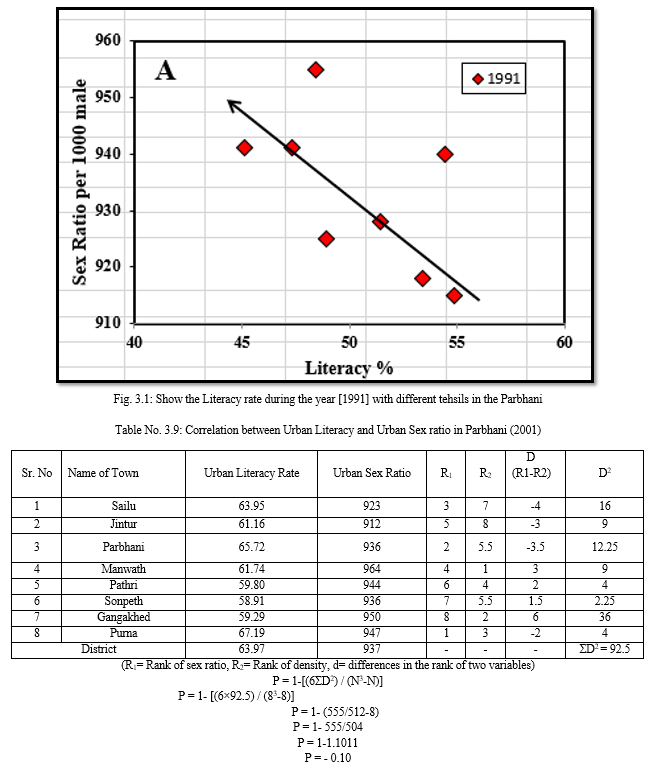
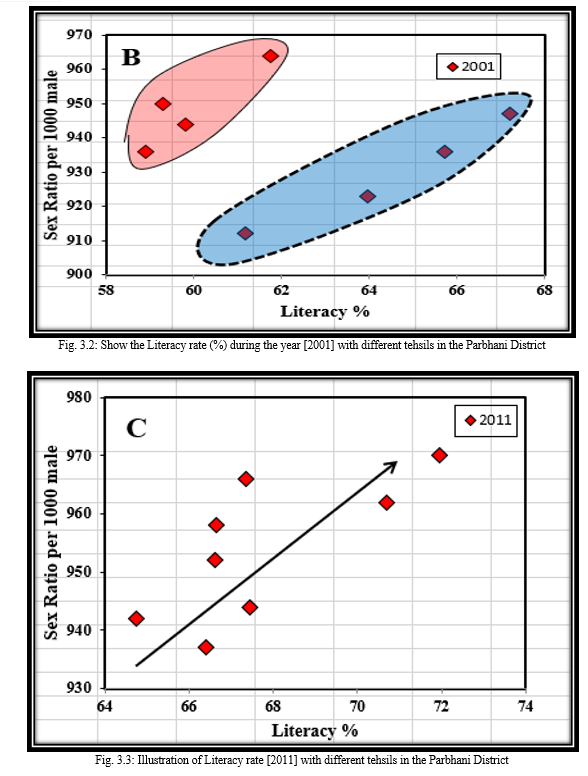
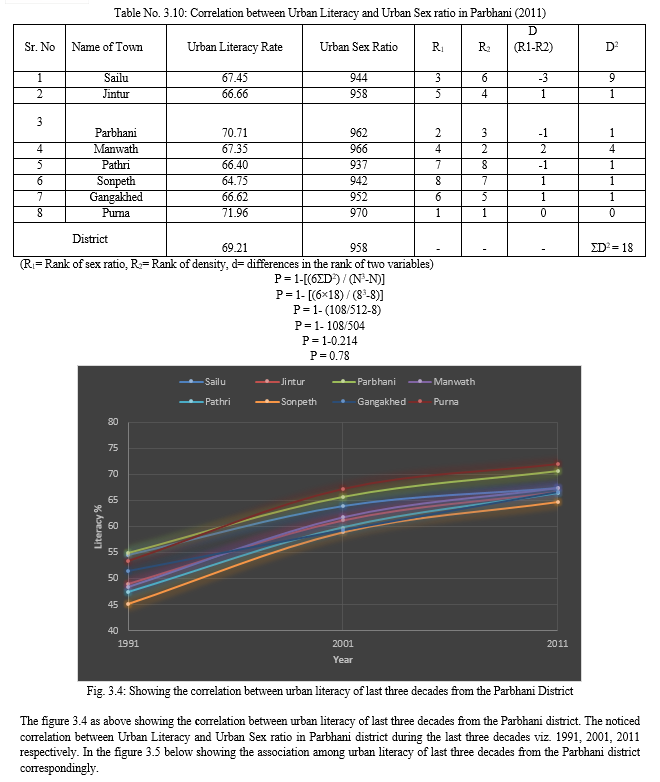
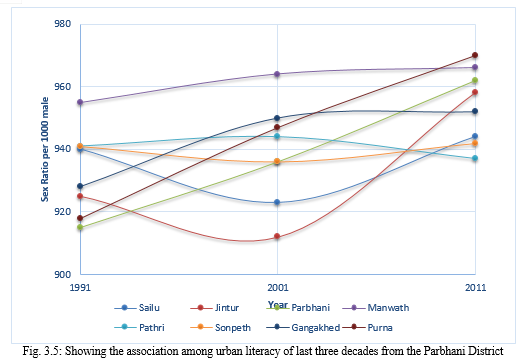
Conclusion
This article investigates the correlation between urban literacy and urban sex ratio in Parbhani district. Literacy rate to the total population of the urban Parbhani district has increased from 52.58 percent to 69.21 percent in 1991 and in 2011 respectively. The increasing percent is 16.63 during the two-decade period of in the district. There is the overall development in the literacy rate of the district is 1991. The urban sex ratio of the district was 924 and according to the census of 2011 the sex ratio is 958 respectively in the district respectively. 1) Declaration: The authors of this manuscript do not oppose the interest. 2) Acknowledgement: We are thankful to the Mahatma Jyotiba Phule Research & Training Institute (MAHAJYOTI), for financial support to this research and the school of Earth Sciences, Swami Ramanand Teerth Marathwada University, Nanded, Maharashtra, India for providing laboratory and library facilities that are helping me to carry on with my work in an effective way.
References
[1] Khadke P.A. and Waghmare P.B., (2017), “Disparities of sex ratio in Maharashtra state of India”, International Journal of Research in social sciences, Vol. 7, Issue 8, Page 627-642. [2] Shinde T.P. (2016) “Correlation between female literacy and child sex ratio in Satara district Maharashtra: A geographical analysis”, American international journal of research in humanities, Arts and social sciences, Vol. 13 No. 1, PP 71-73. [3] Sopher D. E. (1974), “Measurement of Disparity,” the Professional Geographer, 26 (4): 380-392. [4] Sopher, D. E. (1980), “Sex disparity in Indian literacy,” In D. E. Sopher (Ed.), An exploration of India: Geographical perspectives on society and culture. New York: Cornell Press. 130-188. [5] Suman and MS Seema (2014) “Impact of Female Literacy on Sex Ratio: A Case Study of Haryana,” International Journal of Current Trends in Science and Technology, Vol. 7, Issue. 8, Page no: 20281-20286. [6] Suvasree Dutta (2013) “Disparity in the Literacy Level among the Scheduled and Non-Scheduled Population: Indian Scenario in the 21st Century,” Transactions, 35 (2). [7] Waghmare P. B. and Khadke P A (2013) A Geographical Study of Literacy of Nanded District”, in Research Front Journal Vol. 1 No. 3, PP. 15-22. [8] Yannawar VB, Bhosle AB, Khadke PA and Waghmare PB, (2013), Monitoring Physical Growth of Nanded City by Using Geoinformatics Techniques, Researcher, Vol. 5 No. 2, pp. 80-86. [9] Yannawar Vyankatesh B. (2015): The Nanded Information System, Lap Lambert Academic publishing, Germany.
Copyright
Copyright © 2022 Ajitsing S. Solanke , Khadke P. A. . This is an open access article distributed under the Creative Commons Attribution License, which permits unrestricted use, distribution, and reproduction in any medium, provided the original work is properly cited.

Download Paper
Paper Id : IJRASET48161
Publish Date : 2022-12-15
ISSN : 2321-9653
Publisher Name : IJRASET
DOI Link : Click Here
 Submit Paper Online
Submit Paper Online

